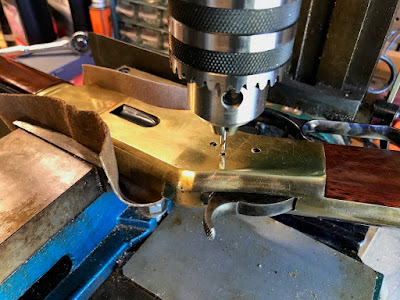AKA, "When I said get out, I wasn't asking."
Earlier this year I bought an Uberti 1866 Sporting Rifle chambered for .38-40 WCF. Uberti build beautiful guns but unfortunately, many of them seem to be assembled by a gorilla who applies 87,000 pound-feet of torque to screws that are slightly harder than cheese.
This rifle is one of them.
I wanted to remove the sideplates from the action to inspect the inside and lubricate it with Ballistol. I also wanted to replace the loading gate cover (AKA ladle) with a stronger, aftermarket piece.
After weeks of soaking in Kroil, I was able to remove the lever screw. However, I still couldn't budge the sideplate screw. Even though I used a properly fitting gunsmith screwdriver bit, all I managed to do was booger the screw head.
A few weeks ago I ordered a set of replacement screws that are properly hardened from VTI Gun Parts. (Part # 220-H.)
So, today I braved the hot, humid Southeastern Pennsylvania weather and went out to my backyard shop so I could use my Grizzly G8689 mini-mill as a drill press.
First, I drilled into the sideplate screw on the end where it screws into the right sideplate. This relieves some pressure on the threads.
Note the use of a center drill for starting the holes. This is important because they are more rigid than twist drill bits and you don't want the bit walking off to the side and damaging the receiver.
Then I flipped over the rifle and drilled into the screw head, and then used a screw extractor held in a tap handle to back it out.
While I had the rifle open I also replaced the lever spring screws. A trick to reduce tension on these so you can move them is to slide the lever springs to the side. This worked for the right hand screw but not the left one. So, back to the mill.
This time I put the screw extractor in the drill chuck and manually rotated it (my mill cannot rotate to the left).
After reassembling the rifle I adjusted the tension on the lever so that it's a little easier to work than before but still holds the lever up.
I won't be disassembling the rifle regularly. Even when fired with black powder cartridges, the .38-40's thin brass seals the chamber very well. Virtually no fouling makes it into the action. (The same goes for .44-40, which I shoot in an 1860 Henry and 1873 Sporting Rifle.) However, I can now easily get into the action should it be needed for repair.
Sunday, June 28, 2020
Removing Stubborn Screws from an Uberti 1866 Sporting Rifle
Labels:
.38 WCF,
.38-40,
black powder guns shooting,
cowboy guns,
guns,
gunsmithing,
machining,
Uberti
Subscribe to:
Post Comments (Atom)












No comments:
Post a Comment